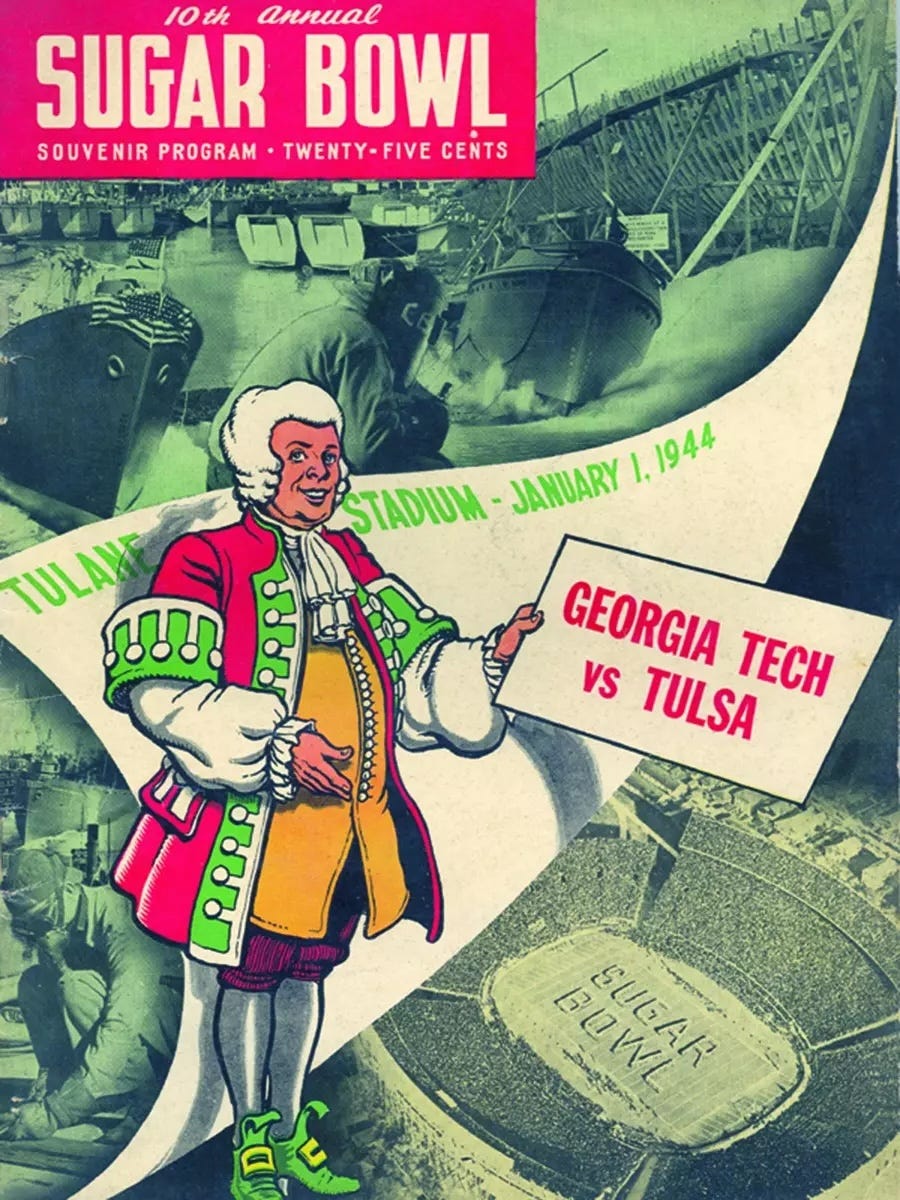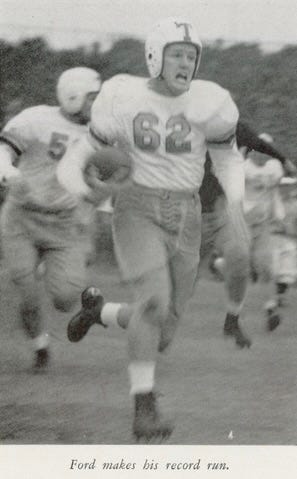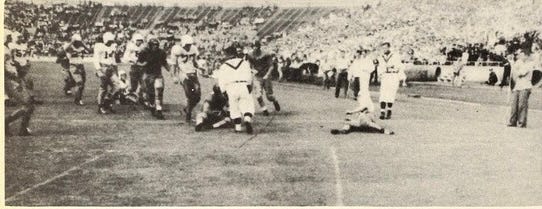Today's Tidbit... 1943 Tulsa and Wartime Conditions
Special thanks to Russell Roberts for suggesting the wartime Tulsa teams as a Tidbit topic.
Henry Frnka had one of the best tenures ever as the coach at a mid-major football program when he led Tulsa from 1941 to 1945, taking them to their first five bowl games while accumulating a 40-9-1 record. While his 1942 squad was his best, ending the season ranked #4, his 1943 team had the most interesting roster, coming as it did in the middle of WWII.
Frnka played at Austin College and spent 10 years coaching in the Texas high school ranks. He then assisted at Vanderbilt and Temple before taking over at Tulsa, a school with an up-and-down record. His 1941 squad went 8-2, winning the Missouri Valley Conference (MVC) and the Sun Bowl, while the 1942 squad went 10-1, winning the MVC again and losing to Tennessee in the Sugar Bowl to finish ranked #4.
The 1943 team would have returned much of its roster in a normal year, excluding the pass-happy, first-team All-American quarterback Glenn Dobbs, who graduated. But 1943 was not a normal year. Weeks before the season began, it was unclear whether Tulsa would field a football team that year, but they did, adding games to the schedule as the season progressed.
Many schools around the country dropped football during the war. In contrast, others received an influx of talent by hosting Navy and Marine V-12 training programs focused on classroom instruction. Tulsa, with only 700+ students, did not have a military training program, but they supplemented their roster in several ways.
First, since the student sailors at schools with military training programs received immediate eligibility -sometimes transferring at mid-season and playing football for both schools- the MVC voted to grant immediate eligibility to civilian transfers while also allowing freshmen to play varsity sports.
Civilian transfers proved critical to Tulsa. Players at schools that shut down their programs sometimes chose to transfer, with Tulsa being among the destinations. The transfers and many of Tulsa's home-grown gridders were in college rather than the military because they had been classified as 4-Fs, the military designation for being physically, psychologically, or morally unfit to serve. Many college football players during the war could not serve in the military for one reason or another. Among Tulsa's 4-F designees were those with vision issues, ruptured ear drums, high blood pressure, a severed Achilles tendon, one kidney, one lung, one arm, and another with a partially functional arm.

They also had a handful of players exempted for being engineering or pre-med students and nine freshmen who were only 17 years old during the season and ineligible for the draft. While many team members could not serve in the military, they remained fine football players.
When the season opened, Tulsa had two seniors, eight juniors, eight sophomores, and twenty-two freshmen, so they were an inexperienced squad. Still, they did not let inexperience or their 4-F status hold them back. Coach Frnka quickly melded the team into a solid unit as they rattled off victories over SMU, Texas Tech, Oklahoma, and Utah, winning by an average score of 32 to 5.
The next game came against Southwestern University of Georgetown, Texas, ordinarily a school of fewer than 400 students. However, Southwestern acquired a Navy V-12 training program, partly through the intervention of local Congressman Lyndon Johnson, nearly doubling the school's enrollment. Among those in the V-12 program at Southwestern that fall were seven players from the 1942 Southwest Conference champion Texas team, nine from Baylor, six from SMU, and four from TCU.
The Monday after the Tulsa game was transfer day when students at V-12 programs across the country moved on to their next station, but Southwestern had their full contingent for the game against Tulsa, and it showed.
Neither team moved the ball well that day, though Tulsa passed its way to a first-quarter touchdown, missing the extra point kick. Southwestern's touchdown came in the third quarter when Tulsa completed a pass, only to see a Southwestern defender grab the ball from the arms of the receiver and run it in for a touchdown. They also missed their kick, and the game ended in a 6-6 tie. Southwestern finished the season 10-1-1, including a Sun Bowl victory over New Mexico.
Tulsa then blew out Oklahoma State 55-6 and Arkansas 61-0 before heading to the Sugar Bowl for the second straight year, this time facing Georgia Tech.

Tulsa dominated the first half, taking an 18-7 lead, and the three missed extra points would prove their undoing. Georgia Tech chipped away in the second half behind the running of Eddie Prokop, whose 43 carries and 199 yards rushing gave Georgia Tech the 22-18 victory.

Tulsa went 8-2 during the 1944 season and avenged the loss to Georgia Tech by beating them 26-12 in the 1945 Orange Bowl. They also went 8-3 in 1945 including an Oil Bowl loss to Georgia. Coach Frnka moved to Tulane for the 1946 season where he remained through 1951, winning one SEC championship.
Tulsa has had periods of success since then, particularly under John Cooper. Still, no one has approached the .816 win rate of Henry Frnka, who cobbled together some great teams under trying wartime conditions.
Click Support Football Archaeology for options to support this site beyond a free subscription.





Ellis Jones was the Pete Gray of football. Should be better known.